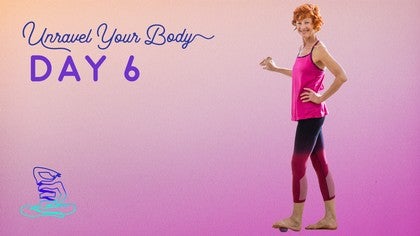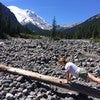Description
About This Video
Transcript
Read Full Transcript
Welcome today for have this challenge today with dealing with the favorite subject matter for much of anybody that I've ever spoken to, which our hips, our hips get tight, stiff sitting as a modern smoking. So most people have very limited range of movement in it and I hope you will gradually restore more and more range of movement with this work. Our pretest is first of all to lie on your back and lift one leg straight up so your heel is right above the hip and then take the other leg in length in it now and atomically this angle of 90 degrees is an angle that every human being should have. You don't have to be unusually gifted or an athlete. We are designed to have this as normal range of movement, but sadly very few people have it. So just check, see what it's like for you. Do you have a slight bend in the knee?
Is it impossible? Does your hip want to pull up when you're doing it with checking the range of movement in the hip socket. Then with the knees bent, check that your hips have a stable. In fact, put your hands on your hips. Can you lift one foot up and put it in front of the left knee without your pelvis swinging all over the place? That's the goal. And then lift the other foot up and see what your range of movement is. Again, checking with checking the range of movement of the hips in the socket instead of just a whole pelvis.
Cause usually people do some kind of wiggles swivel and they actually bringing the pelvic pelvis and maybe the lower back into it. So you want stable bones, don't change your bones, don't change your bones, just check the joint range and movement. Notice what it feels like and then bring it down. So the next part can be a little bit more intense because we're starting to really dig around the socket and mobilize a bone against any restriction there. Just so you see what the journey will be. The, we'll start in this kind of more grizzly, tight area just above the greater trocanter on the side and roll forward and back a few times.
And then we'll do some leg movements because we're basically trapping the tissue. And then checking the mobility of the leg against the trap tissue to make sure there's no kind of holding patterns from there. We very slowly journey through the glute and all the way down towards the sit bone and each section of the way we'll be doing legwork this showing you because it's hard to see when you're lying in the ball and then roll back up through the middle of the glute all the way around, all the way onto the side and then roll just a little bit in front to release any patterns that could be holding right in this. It's more intense. It's amazing what it can do. The first time can be a little bit of a shock.
When I did it I felt like my whole body was like, oh my God, Oh my God. Oh my God. But it was so healing on my hips. I hope you have the same experience. So the next part we work with two balls and your first part you'll be taking one ball quite close to the greater trow cantor area and the other balls next to the sacred and rolling them back and forth just to massage across the glutes. Glutes can really lock into the hip bones in the socket and we'll also be moving up a little bit and down. It should feel really, really good.
People love this one so I hope you want to have that experience. So I'm lifting up one side is close to the sacrum, the other one is closer to the greater truck canter and now I'm just going, I'm like salsa dancing, I'm just rolling back and forth, but I am putting pressure into the balls. The idea is to break up any adhesions in the glute muscles or spasms and you can also roll a little bit up and a little bit down and if you feel a little clunky, knotty areas, which I am finding you want to spend a little time visiting them and maybe doing little micro movements into that area. The feeling should be that when you get close to the greater trochanter or the thighbone, you want to almost feel that you're widening this area and I have my, my balls start to get really nice and wide. So that's what you're looking to do.
Getting this transition. Now very occasionally I have somebody with this is too much, too extreme and you can do exact same movement with the balls against the wall. So you're standing and then you're choosing how much pressure to put in. That's for people who are really, really, really tight. Then lift your hips up and just let them sit down and the next part will be sitting where you take only one of the balls and you place it under your sit bone and you want to feel that you're hooking your sit bone backwards.
And what we'll be doing is actually lifting up the glutes a little bit. So sitting up, I'm taking that Sitz bone and slightly widening it and then very slowly rolling with a lot of pressure into the ball through the central line of the glute is as though I'm trying to lift my bottom up and pull it away from the sit bone cause all of those muscles drop because and now have come to the pelvis and then I come back, I get it just in front onto the sides. I'm on the right side of my sitz bone and I'm pushing into it. So it's a tissue you're going to get into glute medius. Oh yes, right there. I know I need it and I'm pressing and lifting as I roll all the way up towards the crest of the pelvis.
And now I'll do the same. I'm going right inside the Sitz bone and rolling through. So now I'm rolling on the side of my sacred with the concept of lifting and stimulating all the muscles in the glute. I'll do the same on the other side. So here I am, I'm sitting on the left sit bone, nice and tall. Let me turn the other way and rolling through.
Lifting the glute muscle up. We all want nice perky buns. We don't want drop buns can be a problem as we get older to the right left side. Now I roll to the outside of the sit bone so it's right widening the greater trow cantor and again, I'm pushing through all of that tissue rolling through and lifting up. And again, if any of these areas are more painful, you can always lighten a little bit, sink lightened a bit sync and also trust the process. You can revisit this area. Something's really extreme for you.
Now I'm on the inside rolling up. If anything is extreme, go back. Do it again. Repeat it. Two, three, four days. You will be amazed. You will get to the other side of the pain and the holding pattern quite fast. The body loves to let go of tension and you may be amazed at how much better you feel and that maybe you didn't even know you felt that bad before you started. So that that's the first two exercises.
So now we'll work right around the hip socket. This can be intense the first time you start doing it. It can do miracles for how comfortable and lubricated your hips are and sometimes we store a much more healthy condition to them. If they've started degenerating or calcifying, you will be on just above your greater trocanter. Now if you notice, I'm actually lifting my body up, I'm not relaxed and this leg is long and there's fibrous tissue in that area right on the side of the pelvis and just going to go forward and back a few times just to soften it up and get it more hydrated, more elastic, less than a holding pattern. For some people it's tight. For some people it's nothing. You'll elders have to see what it's like for you.
Now pausing here, lift the leg, lengthening it out. Now we're starting to pull the hip and the whole leg muscle away from that contracted congestion, which can start this. Make the bone be sticky. One more time. I'm lifting the leg, keeping my body long and down. Now my pressures into the ball and now I'm rolling a little bit back.
So I am now pressing into the outer part of my glute. Lifting the leg up while I'm putting pressure into the ball, lowering the leg down, real leasing into the ball. If I've started to tighten up against it, now I turn the leg in, lift the leg up, lower down, turn the leg out, lift the leg up, and imagine someone's grabbing my ankle and pulling it away from me so I'm actually mentally tractioning the bone in the socket. Now I'm rolling further so I'm actually right in the middle of my glute and spreading the muscles there. Lifting the leg up long, long, long reaching leg down. Internally, rotate as best I can from the hip socket, not the foot. Lengthening it out, keeping it long and down some.
None of the muscles are relaxed and then rotating the leg out, lifting it, lowering it down, staying into the ball. Now I'm rolling even further back, so I'm just above the sit bone. I'm actually hooked into the sit bone and pushing it down to open up the space of the hip or the [inaudible]. It's literally a journey around the socket, lifting the leg, lowering it down internally, rotating, lifting the leg, lifting it more and down and externally, rotating, lifting the leg, extending the leg, reaching out as much as you can and down. And I just felt a whole part of my glute let go because it was resisting and now the ball went in. You want the ball eventually to go all the way to the bone. And then very slowly returning with my journey through the side, all the way to the side of the hip, a little bit rolling forwards and rolling over my hip bone into the front of the pelvis and just letting the tissue in there sink a little bit to let the body restore and then coming off.
So moving onto the left side, I will be with my back to you so you can see what's happening from that side. Placing the ball right above that greater trow cantor in that grizzly area. And when you're here, if you can almost imagine that you're using the ball to traction bone down, it can get pulled up a little bit for some people. So you push into the grizzly part, you lengthen your weight leg away and you imagine that greater trocanter moving downwards. And then just slightly forward, I'm rolling towards my stomach just a little bit rolling back, rolling forward, pushing into that tissue, rolling back at the same time, keeping a nice length on my side body. One more time, rolling forward, visiting that tight area, rolling back and then settling right in the middle on the sideline and lifting your leg and lowering it down long. Now as I'm lifting my leg, I'm imagining someone grabbing my ankle and elongating it out of the socket and for me the left side has more congestion.
I can feel the resistance in my body, so I'm very, very delighted to be finding this resistance as it's such a treat to be able to get rid of it. Now I'm going to move a little bit onto my back and now I've gone into the top part of my glute. Just behind the greater trocanter. Let's see if I can keep this leg down and I'm lifting this leg up, lifting it more, allowing my bottom to sink into the ball and lower it down. I'm internally rotating it, trying to get the rotation from the hip, lifting, lifting more, constantly pushing into the ball and lowering down. And now I'm turning my leg out. External rotation as much from the hip as I can.
Lifting, lifting up, lifting more, constantly trying to check. Am I softening into that ball? Lowering down. Now I'm rolling a little bit through. Sometimes people come up, sometimes people stay down. But I'm into the glute now. I'm right in the middle of my glute and I can feel my hip going and lift the leg lifted more. Feel the length out of the socket and length and the leg down.
Internally rotate as much as the blade will allow. Lifted, lifted, more, lifted more, and lengthen is have someone stretching the leg away from you. Externally, rotate, lift, lift, lift and down. So every time we're asking that hip socket to release a little more. Now I'm moving even further down and I can feel hooking my sitz bone so I'm grabbing that low part of the pelvis and giving it a traction down and the same thing again, I recommend having this knee bent. I'm keeping it straight so you can see what's happening. Lift, lift more.
I now I'm starting to feel my whole hip move in the socket freely. Internally rotate, lift, lift more, lift more and down and externally rotate. Lift, lift more. I'm sinking into the tissue of the glute because we have a tendency to start to tighten into it and now very slowly I'm taking that journey back through the two tissues and my glute onto the side. I can definitely sink a whole lot deeper than I did before.
Right onto the side above the greater trow canter through the hipbone in the front and this rolling inside the hip sinking into the tissue of the stomach, which we will visit more intimately in another day of the challenge. But it's a nice way to release the pal pelvic structure around the hip socket and calming out from here to finish, we retest and see if anything is changed. So lying in your backs with your backlog, the knees are bent to begin with. See what it feels like to lift one leg up to the ceiling and then make sure the leg is not forward, not back. Can you get your heel above your hip and then lengthen the other leg down?
Are they moving more easily or are you, is your pelvis being pulled just the farms. A vacation, same thing on the other side, leg up straight. What does it feel like? What happens when the other leg goes straight? What does that feel like? I hope it feels looser and easier to do. And then with the knees bent, hands on the hips to make sure that the pelvic structure is not going to move when you lift this foot and pull it, put it up. And what? How much hinge do you have available to you?
Right in the sockets, we're less interested in the sockets and other side lifting, lifting more, just seeing, you know, what's easy now it's, it's not an exercise, it's just a test run. So hips get really, really tight. They're very important. So many people as they get older, get hip replacements, do this work. You may be amazed. It'll give you good hips for the rest of your life so you can dance, you can run, you can jump, you can do pilates, you can be happy. This is amazing work. Enjoy it.
Unravel Your Body Challenge: with Niedra Gabriel
Comments
Sharon - use whatever you have for this work, the more you do the more sensitive you will get to how to approach your body. if you felt the roller worked for you - then it did !
You need to be a subscriber to post a comment.
Please Log In or Create an Account to start your free trial.





















